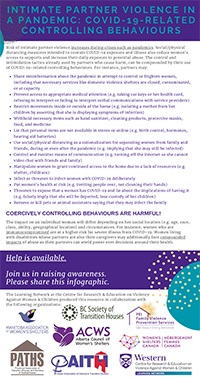Intimate Partner Violence in a Pandemic: COVID-19-Related Controlling Behaviours
This inforgraphic shares how the control and intimidation tactics already used by partners who cause harm can be compounded by their use of COVID-19-related controlling behaviours
View Printable PDF Version
View PNG Version
View Plaintext PDF Version
Risk of intimate partner violence increases during crises such as pandemics. Social/physical distancing measures intended to contain COVID-19 exposure and illness also reduce women’s access to supports and increase their daily exposure to potential abuse. The control and intimidation tactics already used by partners who cause harm, can be compounded by their use of COVID-19-related controlling behaviours. For instance, partners may:
- Share misinformation about the pandemic in attempt to control or frighten women, including that necessary services like domestic violence shelters are closed, contaminated, or at capacity
- Prevent access to appropriate medical attention (e.g. taking car keys or her health card, refusing to interpret or failing to interpret verbal communications with service providers)
- Restrict movements inside or outside of the home (e.g. isolating a mother from her children by asserting that she is displaying symptoms of infection)
- Withhold necessary items such as hand sanitizer, cleaning products, protective masks, food, and medicine
- Lie that personal items are not available in stores or online (e.g. birth control, hormones, hearing aid batteries)
- Use social/physical distancing as a rationalization for separating women from family and friends, during or even after the pandemic (e.g. implying that she may still be infected)
- Control and monitor means of communication (e.g. turning off the internet so she cannot video chat with friends and family)
- Manipulate women to grant continued access to the home due to a lack of resources (e.g. shelter, childcare)
- Infect or threaten to infect women with COVID-19 deliberately
- Put women’s health at risk (e.g. inviting people over, not cleaning their hands)
- Threaten to expose that a woman has COVID-19 and lie about the implications of having it (e.g. falsely imply that she will be deported, lose custody of her children)
- Remove or kill pets or animal assistants saying that they may infect the family
Coercively controlling behaviours are harmful! The impact on an individual woman will differ depending on her social location (e.g. age, race, class, ability, geographical location) and circumstances. For instance, women who are immunocompromised are at a higher risk for severe illness from COVID-19. Women living with disabilities whose partners are also their caregivers may additionally face compounded impacts of abuse as their partners can wield power over decisions around their health.
Help is available.
Join us in raising awareness. Please share this infographic.
The Learning Network at the Centre for Research & Education on Violence Against Women & Children produced this resource in collaboration with the following organizations: Alberta Council of Women’s Shelters, BC Society of Transition Houses, Manitoba Association of Women’s Shelters, Ontario Association of Interval & Transition Houses, Provincial Association of Transition Houses and Services of Saskatchewan, and Women’s Shelters Canada.






